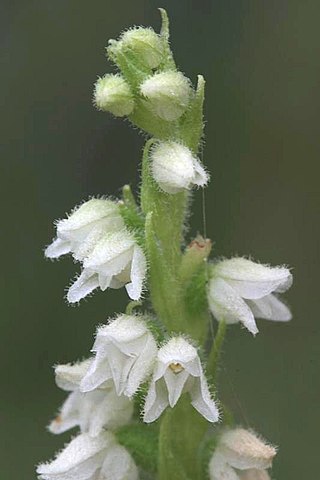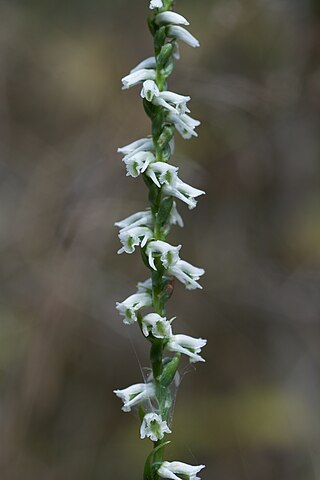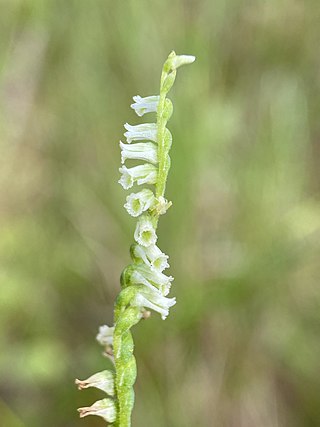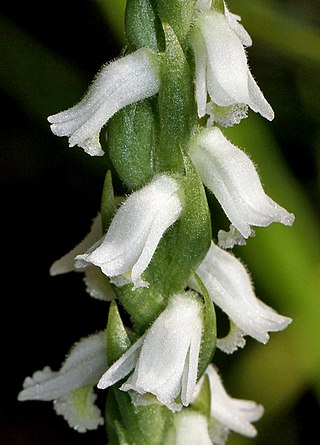
Goodyera, commonly called rattlesnake plantain, jade orchids or ladies' tresses is a wide-ranging genus of orchids in the tribe Cranichideae. About 100 species of Goodyera have been formally described. With a center of diversity in East Asia, Goodyera is found across Europe, Madeira, North and Central America, Australia, and on islands from the west Indian Ocean to the Pacific Ocean. They have a rosette of leaves at their base and usually many small white resupinate flowers. They are similar to orchids in the genus Spiranthes but can be distinguished from them by the shape and colour patterns of the leaves.

Spiranthes romanzoffiana, commonly known as hooded lady's tresses or Irish lady's-tresses, is a species of orchid. Collected by Chamisso during the Romanzov expedition it was described by him in 1828 and named for Count Nikolay Rumyantsev who financed the expedition. This orchid is native to North America, Ireland and the British Isles.

Spiranthes cernua, commonly called nodding lady's tresses, or nodding ladies' tresses, is a species of orchid occurring from Maritime Canada to the eastern and southern United States. As the common name suggests cernua means "nodding", or "bowed" in Latin.

Spiranthes sinensis, commonly known as the Chinese spiranthes, is a species of orchid occurring in eastern and southeastern Asia.

Spiranthes diluvialis is a rare species of orchid known as Ute lady's tresses. The species name diluvialis means "of the flood". It is native to the western United States, where there are scattered, mostly small occurrences in the states of Colorado, Idaho, Montana, Nebraska, Nevada, Utah, Washington, and Wyoming. An occurrence was recently discovered in southern British Columbia. The plant faces a number of threats to its existence. It is a federally listed threatened species of the United States.

Spiranthes lacera, commonly called the slender ladies'-tresses, is a species of orchid that is native to Eastern North America. It has a widespread range and is found in a variety of open habitats, both natural and disturbed. It produces a spiral of white flowers in the summer.

Spiranthes magnicamporum, commonly called the Great Plains lady's tresses, is a species of orchid that is native to North America. It is primarily native in the Great Plains, but there are outlying populations in the east in areas of former natural grassland, such as the Black Belt prairies of the Southeast. It is found in both fens and wet and dry prairies, often in calcareous soil.

Spiranthes ovalis, commonly called the October lady's tresses, is a species of orchid that is native to eastern North America.

Spiranthes incurva, the Sphinx ladies' tresses, is a species of flowering plant in the family Orchidaceae. This orchid is native to the upper Midwest and Great Lakes Basin of North America. The species was originally described as Ibidium incurvumJenn. in 1906. Long treated as part of a sensu latoSpiranthes cernua, the species complex was reevaluated and Spiranthes incurva reestablished as a separate species in 2017. Spiranthes incurva is an ancient natural hybrid of S. cernuasensu stricto and S. magnicamporum.

Spiranthes arcisepala, the Appalachian ladies' tresses, is a species of flowering plant in the family Orchidaceae. This orchid is native to eastern North America. Long treated as part of Spiranthes cernua the species complex was reevaluated and Spiranthes arcisepala established as a separate species in 2017.

Spiranthes niklasii, Niklas' ladies' tresses, is a terrestrial orchid nearly endemic to the Ouachita Mountains in Arkansas and Oklahoma with a few other known populations.

Spiranthes perexilis, the languid ladies’-tresses, is a species of orchid native to California and Oregon.

Spiranthes eatonii, commonly known as Eaton's ladies' tresses is a terrestrial orchid endemic to the United States, closely related to or a variation of Spiranthes lacera.

Spiranthes triloba, the panther ladies' tresses is a terrestrial orchid endemic to Florida.

Spiranthes bightensis, the Atlantic ladies tresses, is a terrestrial orchid native to coasts of the north-eastern United States.

Spiranthes casei, or Case's lady's tresses, is a species of orchid native to the northeastern United States and Canada.
Spiranthes igniorchis, or fire ladies' tresses, is a species of orchid endemic to Florida.

Spiranthes× kapnospria, the smoky ladies' tresses, is a species of orchid growing in North America. In 2023 Spiranthes sheviakii was synonymized to this species.



















